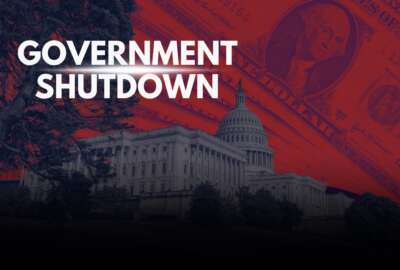A bill with the potential to improve federal spending transparency
"The public is not able to reliably track how the government is spending our money. And this is an issue that merits our attention," Janice Luong said.
Information at USA Spending. gov, it’s simply incomplete. Dozens of agencies don’t report. Another gap is information on dollars awarded to subcontractors. A bill in the House, from New York Republican Nick Langworthy, would improve that particular point, in the view of my next guest. Project on Government Oversight policy associate Janice Luong joins the Federal Drive with Tom Temin.
Interview transcript:
Tom Temin And before we get to the bill, let’s talk about USA spending.gov. It’s, I think, a well-intentioned attempt to in some ways put together in one place all of the federal spending that goes on through contracting. What have you found the reality to be?
Janice Luong So currently, the public is not able to reliably track how the government is spending our money. And this is an issue that merits our attention because the government receives trillions of dollars in taxpayer money because we don’t know where it goes. For some background, when the Federal Funding Accountability and Transparency Act created USA spending.gov in 2006, it was an efforts to improve transparency and hold the government accountable for its spending by creating a central system for entities and organizations to disclose the federal funds that they’re receiving. However, over the years, GAO and POGO found inconsistent, incomplete and inaccurate data from certain agencies. And we’ve also made recommendations to improve the platform. And additionally, when we visited the White House’s site, that on a page called invest.gov, which shows an interactive map on all the announcements made under the four major spending bills, and I’m talking about American Rescue Plan, Inflation Reduction Act, CHIPS act, and the bipartisan infrastructure law. You’ll see that the data source for that map does not reliably use USA spending.gov. Instead, it uses press releases, industry associations, and news articles. So if the administration does not rely on USA spending.gov, how can they expect us to? It’s a problem.
Tom Temin Yeah. So in other words you’re looking to see not just regular appropriated funds and how those are spent, but also, well I guess, they’re appropriated but they’re not the standard types of things. These trillions of dollars raised for this or that perceived problem outside of the normal budgeting.
Janice Luong So we are looking at appropriated funds. However, the data gap is not all agencies are required to report. Currently, agencies have discretion on whether they are required to report. So we are missing some spending, we are not reporting all spending. And that which leads to incomplete and inaccurate and inconsistent data.
Tom Temin Well, the agencies that do report what are those just the CFO act agencies and everybody else is optional.
Janice Luong So it’s not so much that reporting is optional, but the data gap comes from the fact that agencies can evaluate themselves whether they are required to report. Usually agencies such as Department of Transportation, Department of Energy, large agencies, executive agencies, they are required to report. But the thing is, they can basically say, no, I don’t have to report because of I’m not legally binding to do so. And that is an issue because there’s no oversight.
Tom Temin Right. And do we know or does POGO have any estimate of how much funding, how much of the spending is not reported or not available on USA spending.gov?
Janice Luong It is difficult to determine how much spending can be tracked. So let me narrow the scope for you, maybe this will make it a little easier. When we look at the four large spending bills that I mentioned earlier, Politico recently did an analysis, and they found that only a small portion of money was actually spent, and they’ve approximated about 17% of the 1.1 trillion appropriate of appropriated funds has actually gone out the door. Now, since its enactment, billions of dollars have been announced, but we don’t know the actual number or even a reliable estimate as to how much has been spent. When we’re talking about overall, it’s even more difficult to estimate. So the short answer is we simply don’t know.
Tom Temin So that small percentage is all four of those big bills?
Janice Luong Yes. It’s four of those those big bills. And that’s just a very narrow scope of the spending that goes out the door.
Tom Temin We’re speaking with Janice Luong. She’s a policy associate at the Project on Government Oversight and Sub award spending. As we said at the top, that is spending that goes through prime contractors to subcontractors. Why would that be an issue if the money’s going to the Prime, that’s all the money that’s going out. And how would spending on subs affect the total that is reported?
Janice Luong So how it works, as you know, federal agencies, they allocate this portion of money to state agencies, organizations, individuals, any other eligible recipient. And then they could divvy that up to another entity, which are sub awards. And the prime recipients are responsible for reporting the sub award into the system. However, if there is improper guidance from the agencies, then we are just seeing that reporting from the top and it trickles down to the bottom.
Tom Temin All right. Then tell us about this bill that looks to change that. It has a name, but it’s from a New York Republican, Nick Langworthy. And it has some bipartisan sponsors.
Janice Luong So the Federal Sub Award Reporting System Modernization and Expansion Act of 2024, which was introduced by Nick Langworthy and co-sponsored by bipartisan support. What it does is that it requires the Inspector General of the General Services Administration to review and submit a comprehensive report on the Federal Sub Award Reporting System. Now, the requirement for an agency Inspector General to oversee the completeness of award reporting expired back in 2021. This legislation would bring that requirement back. Secondly, it would require the General Services Administration, Office of Management and Budget, and the Department of Treasury to issue annual plans to improve the reporting system until it is fully implemented. It would just allow a more cross-agency effort to oversee the completeness of reporting. Secondly, it would require the GSA to expand sub award reporting. We currently focus on the first tier and we are already having data gaps with that. But also we want to prepare for the second tier of awards and they would be required to do so.
Tom Temin Yeah, the bill would apply to the sub award reporting system, the FSRS, not to USA spending directly.
Janice Luong Yes, that is correct. It would apply to the FSRS and not use spending directly. So USA spending.gov collects that information from FSRS.
Tom Temin In other words, a feeder system that would help improve USA spending would itself be fixed under this legislation.
Janice Luong Correct. Now fixed is a heavy word. But we are hoping that it will definitely improve the data as they definitely work together. They’re not individual platforms. And yeah, hopefully that having correct data reporting an FSRS will streamline to better data in USA spending.gov.
Copyright © 2024 Federal News Network. All rights reserved. This website is not intended for users located within the European Economic Area.
Derace Lauderdale is a digital editor at Federal News Network.






